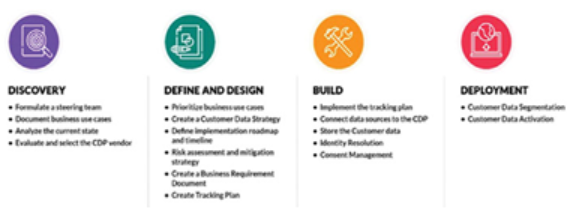The first step in preparing for implementation is to define your objectives. Ideally, you would want the CDP to do everything, but that is not a foolproof plan. You need to clearly state what you want to achieve using the CDP in a 6-month, 12-month, and 24-month goal sheet. The team needs to be realistic in their assumptions. The objectives should take into account your current state of data infrastructure and comply with security and privacy standards.
Some of the objectives to consider are as follows:
- Unified customer view: Create a comprehensive, unified view of each customer by integrating data from various sources such as CRM, website interactions, social media, and customer support. The objective is to have a holistic understanding of each customer’s preferences, behaviors, and interactions with your business.
- Improved personalization: Enhance your ability to deliver personalized experiences to customers across various touchpoints. This may involve segmenting customers based on their attributes and behaviors and using this information to tailor marketing messages, product recommendations, and offers.
- Enhanced customer journey analysis: Gain deeper insights into the customer journey by tracking and analyzing customer interactions and touchpoints. Understand how customers move through different stages of the buying process, identify bottlenecks or areas for improvement, and optimize the customer journey accordingly.
- Advanced analytics and reporting: Leverage the data within the CDP to generate meaningful analytics and reports. Identify key performance indicators (KPIs) that align with your business objectives and track them over time. Use these insights to make data-driven decisions and optimize marketing strategies.
- Improved marketing efficiency: Streamline your marketing operations by automating repetitive tasks, such as data extraction and segmentation. Reduce manual effort and human error while improving the speed and accuracy of marketing campaigns.
- Increased customer engagement and loyalty: Use the insights derived from the CDP to engage customers more effectively and build long-term loyalty. By delivering personalized, relevant experiences and offers, you can increase customer satisfaction, retention, and advocacy.
- Data-driven decision-making: Establish a culture of data-driven decision-making within your organization. Enable various teams, such as marketing, sales, and customer service, to leverage the CDP’s insights and make informed decisions that align with customer needs and preferences.
- Compliance and data security: Ensure compliance with relevant data privacy regulations, such as GDPR or CCPA. Implement robust data security measures and consent management processes to protect customer data and maintain their trust.
From a project management perspective, there are four main phases to a CDP implementation, as shown in Figure 5.3:


